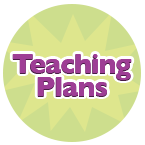Second and further readings are anticipated for all shared reading texts, including those you use for small-group shared reading. Rereading with students allows you to focus on many aspects of early reading such as book handling, print tracking, comprehension, and word recognition and solving. On a first reading, you will highlight book handling, print tracking, and comprehension. The text becomes more familiar to the students when you reread, and you can then focus on word recognition and word solving in addition to a new aspect of comprehension.
Each time you reread a small-group shared reading text with your students, consider using a different comprehension focus so that the students can understand a text’s meaning from different angles.
To change the comprehension focus for a rereading, consider the following steps and then read the lesson that is provided as an example- Read the First Reading lesson and decide on an appropriate comprehension strategy for rereading. You will find a suggestion in the Second and Further Readings section of the teaching plan.
- Change the Before Reading part of the lesson plan to include a link to the previous lesson and a new purpose for reading.
- Change the comprehension prompts in the During Reading section of the lesson so that new aspects of the text are explored. Include a focus on print tracking and word recognition and solving in this portion of the lesson.
- After Reading, revisit the purpose for reading (established in the Before Reading part of the lesson). You may wish to expand the comprehension discussion further and also include more word recognition and word solving highlights. Ideas can be obtained in the Second and Further Readings section of the teaching plan.
Example of a Rereading Plan for a Small-Group Shared Reading Text
An example of a modified teaching plan with a new comprehension focus for rereading is provided. Look over the First Reading lesson and then read the following changes indicated in italics. Use the Small-Group Shared Reading Teaching Plan for jotting down your ideas prior to a second or further reading of a small-group Shared Reading text.
Text: Lost Cat (Level D)
Comprehension Focus: (First Reading) Evaluating/making connections
Comprehension Focus: (Rereading) Predicting/inferring
| BEFORE READING Predicting/inferring |
• Link to the First Reading:
– Revisit the prompts you used in the After
Reading section of the first lesson and
ask the students to recall whether they
thought Fluffy would be found and why. While we are reading I want you to think about what might have happened to Fluffy while she was lost. What adventures do you think she had? • Set a new purpose for reading:– Establish the comprehension purpose for reading |
| DURING READING Print tracking Word recognition and text features Predicting/inferring Inferring Predicting/inferring |
• Hand out the flyers so that each student has a copy. • Invite participation in the reading. Point to each word when we read it. • Pause and use prompts to point out word-by-word finger matching on the headlines. Demonstrate word-by-word matching as you read ‘Lost Cat’ (and then ‘Have you seen Fluffy?’)Which word says ‘Flufy’? How did you work that out? Why do you think ‘Fluffy’ has a question mark after it? Can you find the question mark? • Focus on word recognition. Ask which word says ‘cat’ and ask how the student knows.• Emphasize comprehension by pausing and using prompts: – Where do you think Fluffy is while her family is handing out the flyer? Why do you think that? – Why do you think her family misses her? – Would the neighbours be able to catch Fluffy? Why or why not? |
| AFTER READING Making connections |
So, what do you think happened to Fluffy when she was lost? Do you think she was missing for long? • Provide a prompt related to the purpose for reading.• Extend comprehension by asking the students what they would do if they lost a pet or something they valued. • Focus on word recognition and frame one or two high-frequency words with coloured acetate or Wikki Stix. • Focus on word solving and target the word ‘feet.’ Point out the word and ask students to generate one or two rhyming words. |
